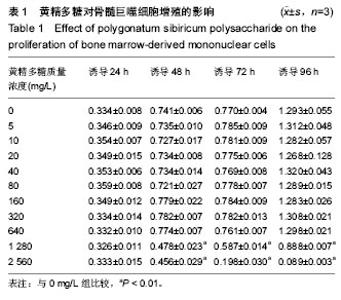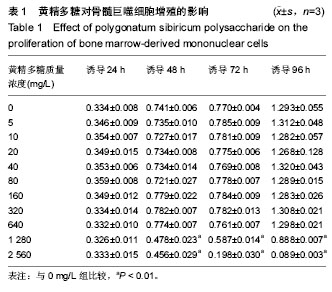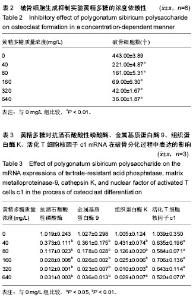| [1] Roodman GD. Mechanisms of bone metastasis. N Engl J Med. 2004; 350(16):1655-1664.[2] TanakaY, Nakayamada S, Okada Y.Osteoblasts and osteoclasts in bone remodeling and inflammation. Curr Drug Targets Inflamm Allergy.2005; 4(3): 325-328.[3] Hayashi M, Nakashima T, Taniguchi M, et al.Osteoprotection by semaphorin 3A. Nature.2012; 485(7396): 69-74.[4] 曾祥周.青蒿琥酯对破骨细胞的作用和分子机制研究[D].南方医科大学, 2015.[5] Hennemann A.[Osteoporosis: prevention, diagnosis and therapy]. Med Monatsschr Pharm.2002;25(5):164-167.[6] Beard MK. Bisphosphonate therapy for osteoporosis: combining optimal fracture risk reduction with patient preference. Curr Med Res Opin.2012; 28(1):141-147.[7] 雷震,杨光义,叶方,等.黄精多糖药理作用及临床应用研究概述[J].中国药师,2012,15(1):114-116.[8] 何才通,李文.黄精多糖药理功效研究进展[J].新中医,2014,46(3): 196-199.[9] 胡敏,王琴,周晓东,等.黄精药理作用研究进展及其临床应用[J].广东药学, 2005,15(5):68-71.[10] 曾高峰,宗少晖,邹斌,等.黄精多糖对小鼠骨髓间充质干细胞向成骨细胞分化中ALP和BGP表达的影响[J].中国骨质疏松杂志, 2014,20(7):779-783.[11] 曾高峰,宗少晖,邹斌,等.黄精多糖对小鼠骨髓间充质干细胞向成骨细胞分化中PINP和BMP-2表达的影响[J].天然产物研究与开发,2014,26(8): 1188-1192.[12] 农梦妮,曾高峰,宗少晖,等.黄精多糖调控骨髓间充质干细胞向成骨细胞分化[J].中国组织工程研究,2016,20(15):2133-2139.[13] Udagawa N,Takahashi N, Jimi E, et al. Osteoblasts/stromal cells stimulate osteoclast activation through expression of osteoclast differentiation factor/RANKL but not macrophage colony-stimulating factor: receptor activator of NF-kappa B ligand. Bone.1999; 25(5):517-523.[14] Boyle WJ, Simonet WS, Lacey DL. Osteoclast differentiation and activation. Nature. 2003;423(6937):337-342.[15] Feng X. Regulatory roles and molecular signaling of TNF family members in osteoclasts. Gene.2005;350(1):1-13.[16] Fujikawa Y, Quinn JM,A. Sabokbar A, et al. The human osteoclast precursor circulates in the monocyte fraction. Endocrinology.1996;137(9):4058-4060.[17] Boyce BF. Advances in osteoclast biology reveal potential new drug targets and new roles for osteoclasts. J Bone Miner Res.2013;28(4):711-722.[18] Akchurin T, Aissiou T, Kemeny N, et al. Complex dynamics of osteoclast formation and death in long-term cultures. PLoS One. 2008; 3(5):e2104.[19] Zhang H, Ricciardi BF, Yang X, et al. Polymethylmethacrylate particles stimulate bone resorption of mature osteoclasts in vitro. Acta Orthop. 2008; 79(2):281-288.[20] Kong YY, Yoshida H, Sarosi I, et al. OPGL is a key regulator of osteoclastogenesis, lymphocyte development and lymph-node organogenesis. Nature.1999; 397(6717):315-323.[21] Fata JE, Kong YY, Li J, et al. The osteoclast differentiation factor osteoprotegerin-ligand is essential for mammary gland development. Cell. 2000;103(1): 41-50.[22] Sundaram K, Nishimura R, Senn J, et al. RANK ligand signaling modulates the matrix metalloproteinase-9 gene expression during osteoclast differentiation. Exp Cell Res. 2007; 313(1):168-178.[23] Kim LC, Song L, Haura EB. Src kinases as therapeutic targets for cancer. Nat Rev Clin Oncol. 2009; 6(10):587-595.[24] 吕明波.淫羊藿苷对体外培养破骨细胞影响的实验研究[D].兰州大学,2007.[25] 张毅.阿司匹林对大鼠破骨细胞分化成熟及RANK基因表达的影响[D].第四军医大学,2013.[26] 王霖,毛昱嘉,王文杰.双醋瑞因对破骨细胞性骨破坏的抑制作用及机制[J].药学学报,2006,41(6):555-560.[27] 贺龙刚.青藤碱对RANKL和LPS诱导的破骨细胞的影响及作用机制研究[D].南方医科大学, 2013.[28] 刘铭,张健,陈婷梅,等.低强度超声对颅骨溶解模型小鼠磨损颗粒诱导的骨溶解效应的影响[J].吉林大学学报(医学版),2013,55(2): 304-307+429. |





